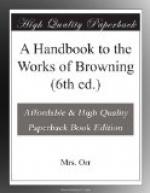[Footnote 9: Vol. i. of the new uniform edition of 1888-89. This will be the one always referred to.]
[Footnote 10: The “Andromeda,” described as “with” the speaker at pages 29 and 30, is that of Polidoro di Caravaggio, of which Mr. Browning possesses an engraving, which was always before his eyes as he wrote his earlier poems. The original was painted on the wall of a garden attached to the Palazzo Bufalo—or del Bufalo—in Rome. The wall has been pulled down since Mr. Browning was last there.]
[Footnote 11: Aristotle.]
[Footnote 12: He rose to meet him from the place at which he stood, saying, “Oh Mantuan, I am Sordello of thy land!” and they embraced each other.]
[Footnote 13: The name of Naddo occurs in this book, and will often reappear in the course of the story. This personage is the typical Philistine—the Italian Brown, Jones, or Robinson—and will represent genuine common-sense, or mere popular judgment, as the case may be.]
[Footnote 14: Elys, the subject of this song, is any woman of the then prevailing type of Italian beauty: having fair hair, and a “pear-shaped” face.]
[Footnote 15: Bocafoli and Plara, mannerists: one of the sensuous school, the other of the pompously pure; imaginary personages, but to whom we may give real names.]
[Footnote 16: The belief in personal experience is very strong here.]
[Footnote 17: The third of these, vol. i. p. 168, is very characteristic of the state of Sordello’s, and therefore, at that moment, of his author’s mind. The poet who makes others see is he who deals with abstractions: who makes the mood do duty for the man.]
[Footnote 18: Walter Savage Landor.]
[Footnote 19: The word “Eyebright” at page 170 stands for Euphrasia its Greek equivalent, and refers to one of Mr. Browning’s oldest friends.]
[Footnote 20: Here, as elsewhere, I give the spirit rather than the letter, or even the exact order of Sordello’s words. The necessary condensation requires this.]
II.
NON-CLASSIFIED POEMS.
DRAMAS.
Our attention is next attracted to Mr. Browning’s dramas; for his first tragedy, “Strafford,” was published before “Sordello,” having been written in an interval of its composition, and his first drama, “Pippa Passes,” immediately afterwards. They were published, with the exception of “Strafford,” and “In a Balcony,” in the “Bells and Pomegranates” series, 1841-1846, together with the “Dramatic Lyrics,” and “Dramatic Romances,” which will be found distributed under various headings in the course of this volume.




